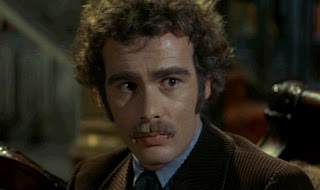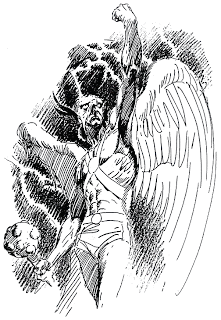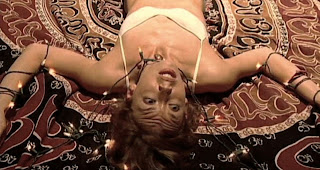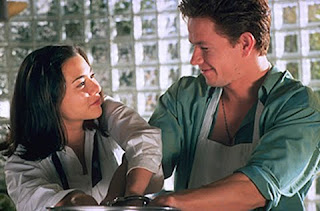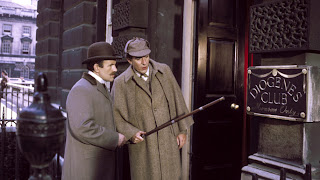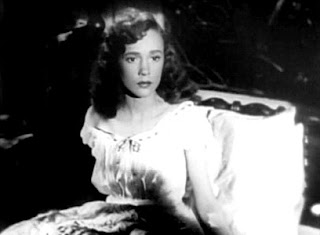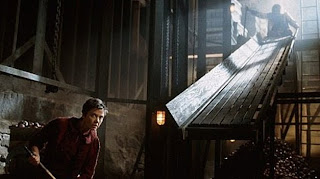I'm reviewing the first two American installmentss of Takashi Shimizu's "The Grudge" series in this post. Tomorrow, I'll be posting the review of the Japanese "The Grudge 2," which seems to follow on the events described in these movies. I don't know if that's just me trying to impose order on chaos, as I don't have the impression Shimizu gives a rip about story continiuity. (And I'm not likely to seek out the original Japanese "The Grudge." The awfulness of these three films has been quite enough for me.)
The Grudge (2004)Starring: Sarah Michelle Gellar, Jason Behr and Medaka Ikeno
Director: Takashi Shimizu
Rating: Three of Ten Stars
In "The Grudge," Americans living and working in Tokyo fall victim to curses and angry ghosts tied to a house in the city. The most recent victim (Gellar) sets out to discover the cause of the deadly and nightmarish events and hopefully to prevent the fate that is occuring to everyone around her to her.

While "The Grudge" features some interesting visuals surrounding the ghosts in the film, the scares are all of the "gotcha" variety, the script is disjointed and badly done, and the activities of the ghosts and the curse never really make any sense.
It's okay to have a crazy ghost with strange motivations. It's even okay to have a ghost with motivations that SEEM to be understandable but which are ultimately revealed not to be. It's okay to have a ghost that may have been a victim in life but which is also completely and utterly batshit crazy and evil. It's even okay to have all of those.
But what is not okay is to have a ghost (and subsequently a ghost story) that seems to have no rhyme or reason to it. Sure, the characters might die horrible deaths without ever knowing what's going on, but the audience should be left with at least an inkling that there is some underlying cause for the haunting and ghosts actions other than a writer/director being too lazy to think his own story through properly.
"The Grudge" is a ghost movie done in by laziness on the part of the creator, and no amount of CGI effects and cheap scares can make up for that laziness. Unfortunately, things only get worse in the sequel. It's a shame that a good cast (including Sarah Michelle Gellar, Sam Raimi and Bill Pullman) are wasted on such a bad movie.
The Grudge 2 (2006)Starring: Amber Tamblyn, Arielle Kebbel, Matthew Knight, Edison Chen, Sara Roemer, and Teresa Palmer
Director: Takashi Shimizu
Rating: Three of Ten Stars
The "most haunted house in all of Japan" continues to curse victims... and now it's gone global.
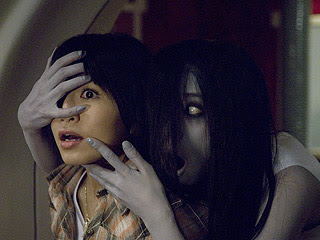
"The Grudge 2" is like the original. It's got the same good parts, and the same bad parts, only moreso in both cases. The curse and its motivation still makes absolutely no sense, nor does the reasons for why the angry ghost targets who she does. In fact, ambiguity is even worse in the sequel, because it appears that the ghost isn't just tied to the house, but that it will go anywhere and target anyone... even people who have absolutely nothing to do with the house or anyone who has ever been in it. Further, it appears that the ghost isn't just the original ghost, but that all its victims are somehow being it. Or something. Or maybe another restless, tormented spirit was house-sitting while the O.G. (Original Ghost) is globetrotting.
Without spoiling too much, this sequel features not just one tale of mysterious hauntings but three--one with Amber Tamblyn and Edison Chen trying to unravel the curse a few days after the events of the first movie; one with Arielle Kebbel and Teresa Palmer a few years later when some mean school girls use the house for a bit of hazing; and a Chicago apartment building where, a few weeks after the ill-fated hazing in faraway Tokyo, teenaged Sara Roemer and her little brother Matthew Knight notice their neighbors start behaving strangely. The film moves back and forth between them, and toward the end of the film it does so in a fashion that seems truly random, and really confuses the viewers sense of what is happening when. I've seen at least two reviews claim the three stories don't connect, and I can only assume that the critics either didn't see the last few minutes of the movie, they weren't paying close enough attention, or they weren't expressing clearly enough the fact that the three stories don't connect in any way that makes sense.
And that is the problem with "The Grudge 2". Nothing in any of the stories feels properly grounded in even a shred of internal logic. There's no reason for "the curse" to target some of the people it does--like every resident on a floor of a Chicago apartment building. Stuff just happens because it's time for something spooky. There are plenty of spooky developments and even more "gotcha!" scares (although a couple of those were more laugh-inspiring on a "Evil Dead" level than actually scary... and I don't think they were going for comedy).
Oh... and here's an illustration of why your Mom told you to always put on clean underwear in the morning.

You never know when you might get caught in a phone booth with a ghost looking up your skirt.





